Chapter 3. Treasures from shifting cultivation in the Himalayan’s evergreen forest Jhum, fishing and gathering food system of the Khasi people in Meghalaya, India
Section 1 Community and food system profile
1. GEOGRAPHIC CONTEXT
Nongtraw is a village located in the Khatarshnong-Laitkroh Community Development Block of East Khasi Hills District, Meghalaya, India. The village is situated in the Cherrapunjee region, a highly dissected plateau along the southern margins of the Meghalaya Plateau in the northeast part of the country. Nongtraw lies along the mid-slope of a deep gorge. There is no road access to the village, so the only way to reach or leave the village is to climb 3 000 steps. Several streams are near the village, with the most important being Wahsohra, situated in the valley below.
This region receives one of the highest rainfalls in the world, with average annual rainfall of more than 1 000 cm (Prokop and Walaus, 2003; Soja and Starkel, 2007). The region experiences a cold temperate climate with foggy winter months. January is the coldest month with average temperatures just above 10 °C and June is the hottest month with maximum temperature approaching 25 °C (Quadir et al., 2004). The main vegetation in the study area is a subtropical evergreen forest. The upper canopy is occupied predominantly by Castanopsis spp., Magnolia insignis Wall., Magnoliaceae, Lithocarpus elegans (Blume) Hatus. ex Soepadmo, Fagaceae, and Vitex spp., Lamiaceae, and the lower layer is composed of Haldina cordifolia (Roxb.) Ridsdale, Rubiaceae, Daphne involucrata Wall., Thymelaeaceae, and Millettia glaucescens Kurz, Fabaceae (Prokop, 2004). Large bamboo species like Dendrocalamus hamiltonii, Dendrocalamus giganteus Wall. ex Munro, Poaceae, and Bambusa bambos (L.) Voss, Poaceae are also common (Prokop, 2004). The upper slopes are dominated by Pinus kesiya Royle ex Gordon, Pinaceae with some broad leaf species like Acacia dealbata Link, Fabaceae, Quercus griffithii Hook. f. & Thomson ex Miq., Fagaceae, and Schima sp., Theaceae (Prokop, 2004).
2. LOCAL DEMOGRAPHICS AND SOCIAL ORGANIZATION
Nongtraw has a population of 250 persons residing in 40 households, according to the latest records by the Accredited Social Health Activist (ASHA) of Nongtraw. Current residents stay in five localities: Khliehshnong, Pdengshnong, Mawsohlah, Wahshatroh and Diengmuiñ.
The Khasi make up almost 100 percent of the population in the Khatarshnong-Laitkroh Community Development Block except for a small number of Bengali, Assamese, Punjabi and Bihari in the Cherrapunjee/Sohra town (Office of the Registrar General and Census Commissioner of India, 2011). Nongtraw, however, is an exclusively Khasi village. The Khasi are an Austro-Asiatic community composed of seven ethnic groups: Khynriam, Jaintia, Maram, Bhoi, Lyngngam, War and Diko (Gurdon, 1914; Nongkynrih, 2007). In this village, only the first three groups are found, with the Khynriam being the main ethnic group. The groups themselves are made up of different clans. Nongtraw has 25 clans: Rani (Mynrieng), Khonglam, Diengdoh, Khongsit, Riahtam, Dohling, Kharshiing, Khongngain, Nongrum, Rapsang, Wahlang, Pyrtuh, Lyngdoh Nongum, Mawpat, Kurbah, Shabong, Khongrymmai, Nongkynrih, Mylliem umlong, Sawian, Thongni, Sohkhlet, Maslai, Lyngdoh Nonglait and Shanpru.
Different Khasi communities have their own dialects. Presently, in Nongtraw, the older generations are the only ones who speak the local dialect. Nongtraw dialect can be used to communicate with nearby villages, but during interaction with upland communities, they use the Sohra dialect. This latter dialect is widely used as the lingua franca within the Khasi-Jaintia areas of the State and is taught as part of the school curriculum, along with English (Marak and Mawroh, 2020). The predominance of this dialect arose because Sohra was the first base for the English in Khasi-Jaintia Hills and it was the dialect used for the first Khasi translation of the Bible. Because of marriage, schooling and involvement in daily wage labour outside the community, new words have gradually entered the local dialect from English, Sohra, Hindi, Maram (dialect from West Khasi Hills), and Khatarshnong (dialect of neighbouring communities from the opposite watershed), and it gradually transformed. The dilution of the original dialect has become particularly intense since 2000. Other than four or five people in the community who still hold onto the traditional faith, all have adopted Christianity. They belong to the Catholic denomination.

The Khasi are a matrilineal society, in which land is owned and inherited by women and clan lineage is traced through the mother’s side (Gurdon, 1914). The youngest daughter plays an important role. She stays back with her parents and gets custodianship of the ancestral property (Mukhim, 2008). People in the community live in both joint as well as nuclear families. In the latter, the father and the mother live with their youngest daughter, who, when married, brings her husband to stay with the family. The other siblings eventually move out of their parent’s house and build a new house for themselves. Within households, there is a demarcation between men and women’s roles. The man is the rice giver and money earner, performing the heavier tasks. Women perform household chores like cooking, feeding, cleaning and washing. They are the ones who handle the household’s marketing concerns, buying or selling. They are also responsible for the cleanliness of the community and its surroundings. The youth and children in the community are involved in many activities, including going to school, helping parents at home or in the field, helping elders with any function in the community, and collecting firewood from the fields and the forest.

© Lyngdoh NESFAS Alethea Kordor.
Traditionally, Khasi Hills has been divided into administrative units known as the Syiemships, which can be equated to the historic princely states of the Khasi Hills (Rao, 1984; Lyngdoh, 2016). Nongtraw is part of the “Sohra Syiemship”. The Rangbah Shnong is the leader of the community who is elected by a voice vote in the Durbar (General Council of the community). The Executive Committee is the main body that executes the decisions of the General Council (i.e. village Durbar). In addition to the Executive Committee, many other committees are set up to assist in implementing the various schemes and programmes introduced by the Government and other non-governmental organizations (NGOs). After the Rangbah Shnong, Members of State Legislative Assembly (MLA) and Members of Autonomous District Councils (MDC) are other important actors for bringing development to the community.
3. LOCAL FOOD PRODUCTION
The food-producing activities in Nongtraw are agriculture, livestock rearing, some amount of fishing, and collection of wild edibles from the forest. In the local perception, food is divided on the basis of where it is sourced, which means jingbam na lyngkha (from the jhum field), jingbam na kper (homestead garden), jingbam na khlaw (forest) or jingbam na wah (rivers).
Crops
All the households in Nongtraw are engaged in agriculture. The most important form of agriculture that people follow is jhum wherein a new plot of land is cleared every year for farming. The old plots are allowed to remain fallow for a period of 7 to 10 years, after which they are again put under cultivation. Crops grown in the jhum field include tubers like yam (Colocasia esculenta), potato (Solanum tuberosum), sweet potato (Ipomoea batatas), cassava (Manihot esculenta), other tubers like phan sawhoin, phan jata and phan shriew (Solanum sp.), and sohlah; vegetables such as: jaïing, jarain (Fagopyrum acutatum, buckwheat), jali (Gynura nepalensis), sla phan karo (Ipomoea sp.), jyllang (Allium tuberosum, garlic chives), mustard leaves (Brassica juncea), cucumber (Cucumis sativus), etc. Fruit trees are also found in the jhum fields with the important fruits being sohbrap (passion fruits, Passiflora edulis), soh pdok (Solanum myriacanthum), papaya (Carica papaya), sohtrun (Ananas comosus, pineapple), etc. The other important crops cultivated in the jhum fields are maize (Zea mays), millets (Eleusine coracana), Job’s tears (Coix lacryma-jobi), a small amount of sugar cane (Saccharum officinarum) and kait khar (Musa sp., banana variety), amongst others.
Jingbam na kper or crops grown in kitchen gardens is another important category of crops identified by the community during the thematic discussions. Here, crops are mostly fruits like banana, sohiong (Prunus nepaulensis, Khasi cherry), sohshang (Elaeagnus latifolia, silverberry), sohpyriam (Psidium guajava, guava), sohlyngdkhur (Morus australis, mulberry), sohphie (Myrica sp., box myrtle), passion fruit and sophan (Artocarpus heterophyllus, jack fruit). Other important crops grown in the kitchen garden are, for instance, sugar cane, bay leaf (Laurus nobilis) and mustard leaves.

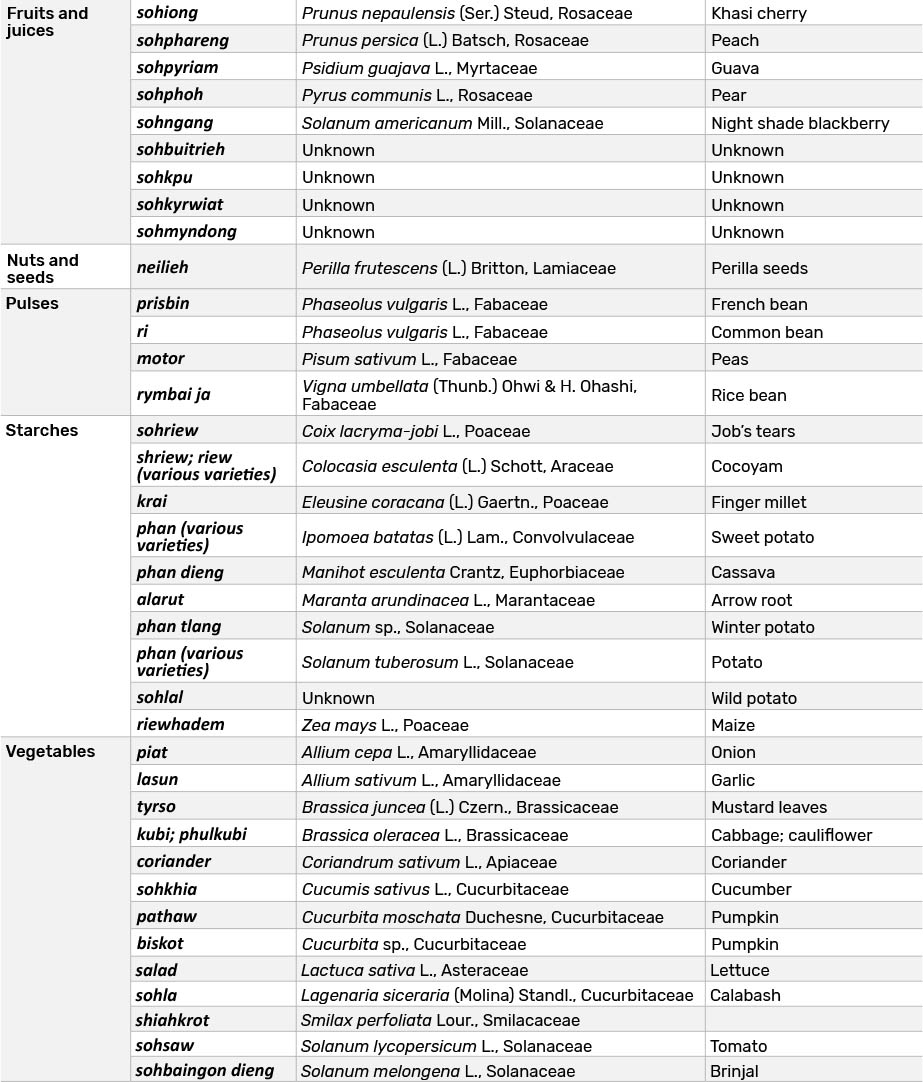
Livestock
Food production from jhum and homestead gardens is supplemented by livestock rearing. All the households rear chickens (Gallus gallus L., Phasianidae). These chickens roam around the premises of the house during the daytime and sleep in the tree at night. Some of the eggs are consumed at home and the rest are sold at the market. The chickens are given cooked as well as uncooked rice, maize and millet. They are fed in the morning and then set free to roam and eat the waste food from their neighbouring houses and any insects they find. In addition to chickens, 15 households practise piggery, which is an important income source. The paddocks for keeping the pigs (Sus scrofa Erxleben, Suidae) are built on the premise of the household. They are fed cassava, potato, rice and wild banana mixed in um sait khaw (leftover water after washing of rice) with skop sniang (husk). Wild edibles like buckwheat, wild banana, jali (Gynura nepalensis), jatwat, jakhi and jasim are also fed to the pigs twice a day, morning and evening.
Beekeeping is another important activity for some households. Big logs are used for keeping the beehives. Another method known as sympa allows the bees to make their hive on a standing tree in the forest. After the hive is completed, the beekeeper takes the beehive home for upkeep and harvesting. Beekeeping households can harvest around 40 litres of honey from two beehives during spring and autumn.
Wild edibles
Connected with the jhum are the forests from where there is jingbam na khlaw (foods from the forests). Wild fruits like sohlymwai, sohum (Syzygium cumini, Java plum), soh thylliang, sohliang, sohkhlot, soh khyrwiah, soh jrumshiah, soh-pong, sohshiah (Rubus ellipticus, Himalayan raspberry), sohmad (Citrus medica, citron), sohkhawiong (Rubus niveus, snowpeak raspberry), soh khaw-iong (Amomum aromaticum), sohpen (Eriosema himalaicum, Chinese bush carrot) and wild edibles like buckwheat, jali, jakhria, ka nub, pashor kait, tyrkhang iong (edible fern), jaïing and so on are important food items that people collect from the forest. These are found in greater numbers in summer as compared in winter. Honey is also collected from beehives from the forest. Wild edibles like jaïing and garlic chives are important products sold to the market by the community.



In addition to wild edibles, people collect many medicinal plants from the landscape. The important ones are bat tyrphin (Eucalyptus tereticornis Sm., Myrtaceae) – for curing toothache, food poisoning or stomach-ache; khnaing; bat rben (Bryophyllum pinnatum (Lam.) Oken) – used for curing wounds, fever, cold, burns and for making chutney; lapata (Vitex negundo L., Lamiaceae) – used for curing sprain, pangat for strain in the veins; mebteng – used for curing cuts; and bat baidoh (Sida rhombifolia L., Malvaceae) – for curing boils by crushing the leaves and placing them on the boil, which helps pull out the pus. Other common medicinal plants used by the people are sla pata, soh jalu and sla rynsi.
Hunting and trapping
Meat from the wild is also included under jingbam na khlaw and has always been an important source of food for the community. Presently, the community occasionally gets meat from the wild. People trap animals for eating like phyllad (Mustela sp., weasel), dkhan (Heterocephalus sp., mole rat), khnai lum (Sundamys infraluteus, Mountain giant sunda rat), khnai lieng (Sundamys sp., rat), risang (Dremomys lokriah, orange-bellied Himalayan squirrel), syllih (Petaurista philippensis, Indian giant flying squirrel), ksar (Prionailurus bengalensis, leopard cat), syiar khlaw (Gallus gallus, red wild fowl), bsad (Viverra zibetha, large Indian civet) and lymbit (Chiroptera sp., bats). Men and especially children go to the forest to hunt and trap mole rats in the winter.
Fishing
Some of the people from the community catch fish from nearby streams for household consumption. A few people will sell some of their catch to other members of the community or to people outside the community. The fish species caught from the nearby stream are dohsher (Garra lissorhynchus, Khasi garra), dohsher iong, sher syngkai, dohthli (Channa orientalis, Ceylon snakehead) and khasaw (Neolissochilus hexagonolepis). The latter come up in the river during the summer season from the plains of Bangladesh and return during winter, only to return the following summer. Dohpieh, dohjiar (Anura sp., species of frogs, the latter being of greenish brown colour), ka lun (Anura sp., tadpole), dohkad (Anura sp.), dohlun (Anura sp.) and tham (Uca sp., crab) are some of the other animals caught from the streams and brought home. Fishing is mostly done during the summer season as the fishes hide themselves in crevices during winter and are difficult to catch.
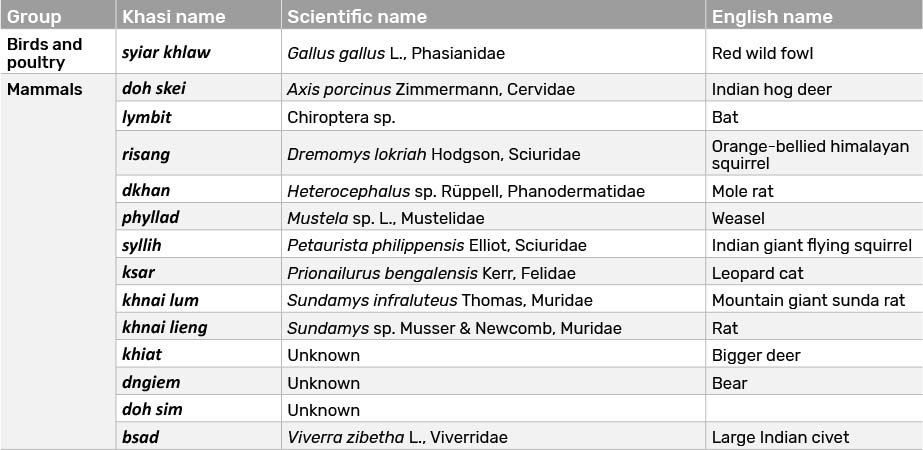
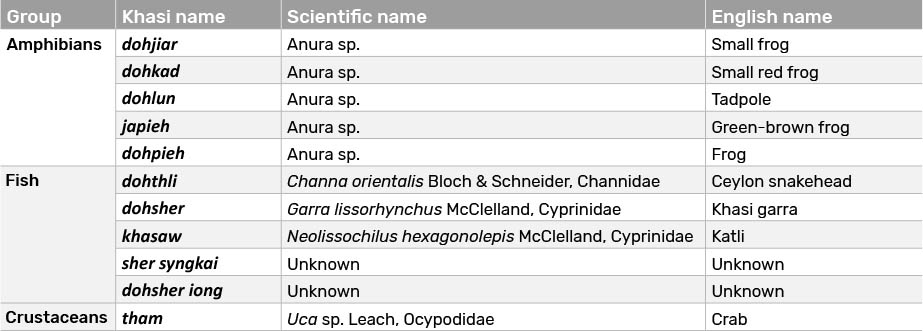
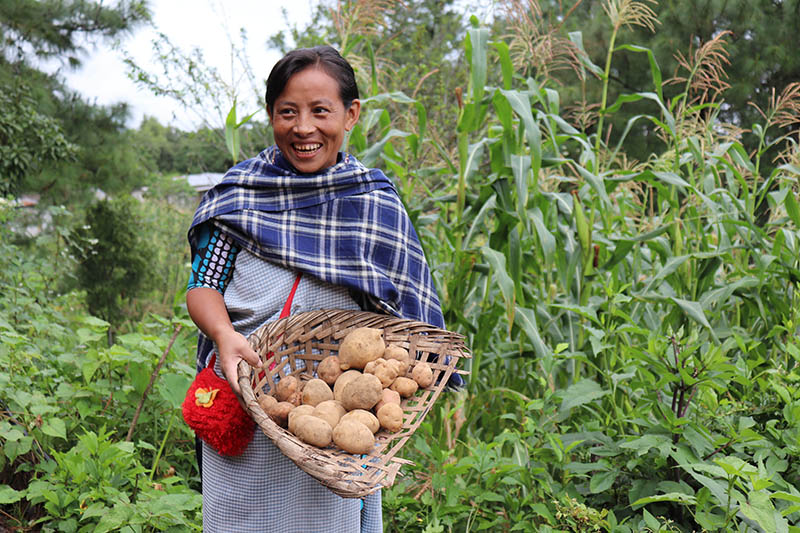
© Lyngdoh NESFAS/Alethea Kordor.
4. OTHER LAND-BASED PRODUCTIVE ACTIVITIES
In addition to food production, several important non-food plants are cultivated in the community as well. Synsar (Thysanolaena latifolia, (Roxb. ex Hornem.) Honda, Poaceae, broom grass) is the only pure-cash crop grown in the jhum fields. It is a main cash income for many households. Shken (Bambusa pallida Munro, Poaceae, a variety of bamboo) is an important crop that people use for constructing houses, weaving baskets, making pigsties and fencing their kitchen garden. Other important non-food plants are phlang tylli, phlang riat, phlang saw, phlang sharait (all types of grass), prut and sla kait (Musa sp., banana leaves). Phlang tylli is used as roof material or to cover the sides of the house; phlang riat is kept in the livestock shed; phlang sharait is kept in the basket where chickens laid their eggs so that they do not break, and sla kait is used to wrap potato seeds. Tangduma (Nicotiana tabacum L., Solanaceae, tobacco) is both cultivated and gathered from the wild by the community for their own consumption.
Apart from farming, almost all the households in the community are engaged in thainkriah (basketry), which is the activity of making baskets out of bamboo. Various types and sizes of baskets are produced, including kriah phan, kriahsohsaw, kriahpiat, kriahdkhar, khohtyntong and kriahprah. This ancient skill from their ancestors is currently a major source of income for the community. The work is carried out throughout the season because it is in great demand. Mostly men make baskets, as few women have acquired such knowledge. Shken is the raw material for baskets and it grows around the houses of the people. However, increasing demand cannot be met from local bamboo production. As a result, artisans from the community buy bamboo from other areas to make their baskets.
5. LOCAL CALENDAR
The traditional calendar of Nongtraw has 12 months. It is a lunar calendar, where the beginning and end of the month correspond with the phases of the moon. The people count the month after every four weeks because that is when the moon appears again. According to the community, on the first day of its appearance, the moon cannot be seen because it comes out along with the sun. The people continue to use the traditional calendar for guiding their farming decisions. They increasingly use the Gregorian calendar for other everyday decisions.
The community recognizes four seasons in the year: winter, spring, summer and autumn. Winter includes the months of naiwieng (November), nohprah (December) and kyllalyngkot (January). This season is the coldest of the year. Blowing of cold winds signals its onset. Spring starts from rymphang (February) and continues through lber (March) until iaïong (April). According to the community, spring is the season of new beginnings and rebirth of the plants. Trees and bushes that had lost their leaves during winter begin to grow new leaves and most flowering plants bloom during this season. Animals and insects emerge out of their holes or dens to meet and enjoy each other’s company. The blooming of tiew maitong flowers heralds the beginning of April. Meanwhile, birds like sim puhnei fly in flocks. Spring is also the season of thunderstorms, especially in April. Spring is followed by summer, beginning from jymmang (May) and continuing to jylliew (June) and naitung (July). This is the season of landslides caused by heavy rainfall. When the blue worms start climbing up from the river in April and May, people know that summer is approaching. The tiew jymmang flowers bloom at the beginning of May. The season is known as the youngest daughter, who is very important in Khasi culture. June is the month considered to receive the highest rainfall. July is called naintung because of the smell, which comes from the decomposition of weeds or agricultural wastes in the hot and humid climate. The last season, autumn, includes nailur (August), nailar (September) and risaw (October). According to the community, this is the season when trees shed their leaves, grass changes colour, and the rivers start running dry. Insects like niang kongwieng, shalymmen, niang krai, niang sbai, niang sohriew, niang kseng and niang ktang all come out within a week of each other in August. Leaves start falling and the surroundings become beautiful in September. The wind that blows during this season is cool and it is nice to spend leisure time in the hills and rivers. When lightning strikes during this season, it is a sign for animals like snakes, worms and other insects to go back to their holes. When the blue worms descend again in September and October, they twist themselves into a ball and their downward movement is a sign that winter is coming. Bamboos begin to crack and break in October. The end of autumn and beginning of winter is accompanied by increasing dryness of the soil and people’s skin, and headaches amongst the people.
January corresponds to kallyalyngkot in the local calendar, which is named so because kylla means “to turn”, alluding to the fact that in this month people turn the logs in the fire to keep themselves warm. In January, men clear the forest for jhum cultivation and fell trees for dienging (house construction). Logs are collected and kept laterally along the borders of the fields to prevent kynring dieng (soil erosion). Women are also engaged in these activities and they spend time collecting firewood. To get the land ready for sowing, the fallen biomass is burned with the weeds so that the ash can fertilize the soil. This process, called thangdieng, takes place between the 15th and 20th of February and all households from the village take part. The weeds must be burned before the arrival of the rains. Once the ash has settled down, planting can begin. Women are the main actors for sowing seeds. Some of the households start sowing potato and maize and by March the whole village has started planting cassava, jaïing (a domesticated wild edible), sesame, mustard and ri (Phaseolus vulgaris, beans). The month of April is associated with the black colour and is considered inauspicious, so people do not build their houses or get married during this month. In the first week of April, until the 7th and 8th, people start sowing millet, Job’s tears and sesame. Shken (a variety of bamboo) and banana are also planted. In June, people start sowing cucumber in their fields. The first batch of potato crop is harvested and another batch of potato and maize is planted. In July, they sow sweet potato, which is the last crop. Summer is the main planting season for the community, which continues until August. Cleaning and weeding of the field is also done in this season, which women perform at least thrice in the year between June and November. Wild edibles are especially plentiful during the summer. Both men and women pluck them on their way home from the fields. In October, millet blooms, whilst crops like Job’s tears, sesame and rice bean (Vigna umbellata) reach full maturity. November is the month when people start harvesting. The important crops in this season are yam, millet, Job’s tears and sesame. Men help in harvesting blackberry from the trees around the village for sale in the market. In December, the harvest continues with yam, Job’s tears, rice bean, sweet potato and cassava. Crops like mustard leaf, motor (Pisum sativum, peas), phan tlang (winter potato), kubi (Brassica oleracea, cabbage) and salad (Lactuca sativa, lettuce) are grown during the winter for self-consumption. Men and women also harvest broom grass in this season. Men and children go to the forest to hunt and trap animals for food, especially mole rats. The community is busy with celebrations.
6. MARKET SOURCING AND TRADE
The market has become an important source of the community’s dietary needs, currently providing approximately 40 to 50 percent of foods consumed. Items like dal (Lens culinaris, lentil), egg, rice and potato are bought throughout the year from the market. Other food items bought regularly include beef, pork, radish (Raphanus raphanistrum), turnip (Brassica rapa), carrot (Daucus carota), beetroot (Beta vulgaris), grams, sugar, salt, mango (Mangifera indica), apple (Malus sp.), sohlang (Viburnum foetidum), gooseberry (Ribes uva-crispa) and grapes (Vitis vinifera).
Nongtraw has a few shops open every day where people can buy household items to fulfil their daily needs. However, many products have to be bought at other markets that are further away in Sohrarim, Laitryngew, Sohra and Shillong. Sohrarim is an hour’s climb from the village and has a few shops where people can buy items such as tea and snacks. The shops are open throughout the week except on Sundays when people go to church. Laitryngew is a weekly market located 4 km from Sohrarim. Farmers go to this market to sell some of their produce and to buy household necessities, especially meat. Around 20 percent of the goods from the village find their way to this market. Sohra, located a bit further away (13 km) from Sohrarim, is the most important market where people go to sell their produce on a weekly basis. Apart from being the main destination of their agricultural products (70 percent are sold here), Sohra is also the market from where they buy most of their essential items. Sohra’s importance is due to the fact that it is an old market that has been in existence since the pre-colonial period. Amongst the bigger markets of the region, it is the most accessible. It has the best diversity and quality of products available in terms of both food and non-food items. Shillong (41 km from Sohrarim) is the biggest market in the region. It is a daily market where people from all over the Khasi-Jaintia region come to sell and buy goods. An estimated 10 percent of the products made by the community reach this market, including baskets and some silverberry and blackberry. Occasionally village members will visit Shillong to deliver baskets and buy essential items.

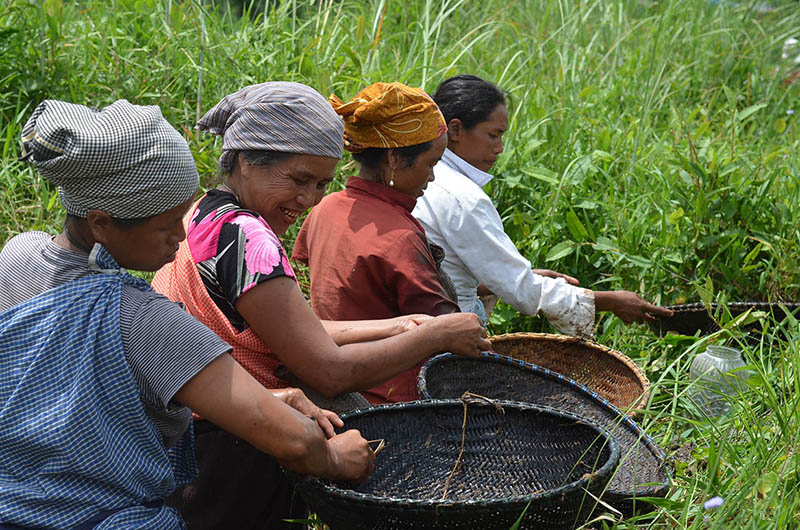
© Lyngdoh NESFAS/Alethea Kordor.

7. COMMUNITY HISTORY AND FOOD SYSTEM TRANSITIONS
Before the 1960s, there was no settlement at Nongtraw. The area was covered with forests in which the people from the surrounding area practised jhum cultivation. Two brothers from the Nongtraw clan came and settled in the area for farming. After marriage, the two brothers left the area for their wives’ villages, following the matrilocal custom of the Khasi. In 1958, four families belonging to four clans came to the area in search of cultivable land and they established the village, naming it Nongtraw after the two brothers who were the first to settle in the area. These four clans came from different villages. Dohling came from Rikyrshang, Rani and Khongsit came from Wahsohra, and Khonglam came from Shnongphong.
The second major event for the people was the establishment of the village school in 1964. After the families had settled down for a few years, they decided to open a school. The community applied to establish a school to the parish of Sohra (Cherrapunjee), which was under the priesthood of Father Carmelo. He accepted their request and within a week a school was established. In the beginning, the school had no building and operated out of Khno Diengdoh’s house until a building was allotted for that purpose. Initially, the school had only 15 students and one teacher. The establishment of the school attracted people from different villages to Nongtraw, contributing to an increase in population. In fact, the 1960s were characterised by the arrival of new households to the village. The families that arrived had different reasons. An outbreak of malaria in Wahsohra forced families to migrate to Nongtraw. Catholic families from surrounding villages were attracted to the village. Even those who were not Catholic when they first arrived later become converts. The establishment of the school was also a big attraction for families. Finally, compared to other villages, governance in Nongtraw was considered efficient and this attracted those who wished to live under a more receptive institution.

© Lyngdoh NESFAS/André J. Fanthome.
The Bangladesh Liberation War in 1971 was a period of great turmoil. This led to the foundation of the nation of Bangladesh, located just 60 km south of Nongtraw. The war affected Nongtraw especially in terms of food security, as the village experienced food shortages during this time. After Meghalaya attained statehood in 1972, an upturn in the area’s fortune occurred when the Government improved its service delivery and the market became stronger. People’s lives changed tremendously in subsequent decades, beginning in the 1980s and intensifying in the 1990s. The Public Distribution System (PDS) was introduced in the 1980s, providing subsidized rice and sugar products. Electricity came to the village in 1992. The Public Health Engineering Department (PHE) initiated the community’s public water supply in 1998. Since 2000, roads have improved and vehicles have started ferrying people from one place to another.
The farming system in Nongtraw has remained the same since the village was established. People still practise jhum cultivation. However, the foods produced, consumed and traded by the community have changed considerably over time. Until the mid-1990s, people in Nongtraw consumed primarily local grains, vegetables and tuber crops that were grown in the local landscape. Sweet potato, millet and cocoyams were the staple diet of the people in the area. Plants and animals from the forest supplemented their diet. With the introduction of the PDS in the 1980s, along with increasing incomes and market access, rice has become ubiquitous in the diet and is the most important food of the community. It has taken the place of millet and other grain crops like Job’s tears. In general, the amount of food sourced from the wild has decreased over time. In the past, when harvests were not ready, people would go to the forest and collect wild vegetables and fruits.
From 1960 to 1970, the people of Nongtraw exchanged goods like Job’s tears, cassava, maize, cucumber, syiar (chicken), rice bean, sesame, sweet potato, banana, potato, millet, yam, etc., with the surrounding communities of Wahsohra, Diengsong, Dewlieh and Tyniar. These exchanges typically happened twice a year during the planting season between the months of February and July. Now, however, the barter system is no longer practised, with people exchanging goods for money rather than in kind.
“Burom ia ka mei ramew bad ka hi kan sa theh ia ki jingkyrkhu ha ngi.”
“Respect Mother Earth and she will shower her blessings on us.”
Richard Ranee, custodian farmer and artisan in Nongtraw.
